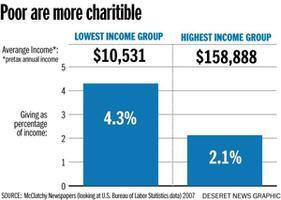An article on the Atlantic’s site this week is summed up in one simple line: “The wealthiest Americans donate 1.3 percent of their income; the poorest, 3.2 percent.” The percentage difference is relatively small but certainly significant enough to warrant examination and the implications growing out of this are rather interesting when considering these facts along with some typical debate points.
Three key factors should be addressed:
- Why is there such a difference?
- What does this mean in relation to how the U.S. government gives in foreign aid?
- What does this mean in relation to social policy and economic arguments?

Know how the Bible says the rich man gets into heaven? Not this way.
Two of the key reasons for the difference are pointed out in the article. The first is no surprise: the rich are greedy and prefer to hold on to more of their money. But the second reason is a little more significant and should be considered further: economic segregation. From the article:
Notably, though, when both groups were exposed to a sympathy-eliciting video on child poverty, the compassion of the wealthier group began to rise, and the groups’ willingness to help others became almost identical…greater exposure to and identification with the challenges of meeting basic needs may create “higher empathy” among lower-income donors…researchers analyzed giving habits across all American ZIP codes. Consistent with previous studies, they found that less affluent ZIP codes gave relatively more.
The fact that ZIP codes can determine how generous an area can be is a big part of many problems arising in political debates. For example, many people on the right (usually wealthy pundits and politicians) make the argument social services aren’t needed and the poor just need to pick themselves up by their own boot straps. This argument sounds reasonable until you realize the rich likely have no idea what the poor are truly up against in their areas of town and in their personal lives since they generally spend little to no time in poorer areas.
The reality is they do not see the conditions and do not understand the obstacles as our cities become more and more segregated along economic lines. And if they do not get this part of the debate, what does their argument even mean other than useless rhetoric? What are they backing this “boots straps” idea up with? The answer is: nothing, other than their own experiences which does not typically mimic that of the poor given the lack of economic mobility in the U.S.
Another argument that rages on, especially now as the government looks for ways to shrink the budget, is foreign aid. The wealthy giving less than the poor in terms of percent given is similar to the reality the U.S. gives less than many other countries around the world as a percent in foreign aid. Whether it’s calculated with percent of GDP or GNI, the United States gives fives times or more less than the most generous countries around the world.
An analogy should be used when showing this difference. Pretend you have two people who go to church each week, Patriot Jesus and Actual Jesus. Actual Jesus brings home $100 a week and gives $10 to the church (the usual expectation of Christians in terms of percentage, by the way). Patriot brings home $1000 a week and gives $20. Who is more generous? The guy who gives ten percent of what he makes or the guy who gives two percent? The answer should be obvious.
Guess which one the United States is in this scenario.

